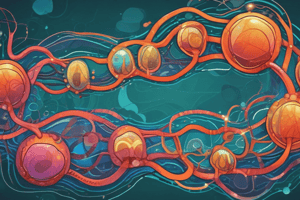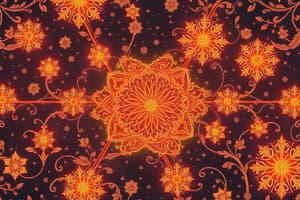Podcast
Questions and Answers
What is the energy source used for ATP synthesis in oxidative phosphorylation?
What is the energy source used for ATP synthesis in oxidative phosphorylation?
Energy released by the flow of H+ down its gradient
What is the role of ATP synthase in oxidative phosphorylation?
What is the role of ATP synthase in oxidative phosphorylation?
Coupling energy from H+ flow with ATP synthesis
How many protons are needed for the synthesis of 1 ATP?
How many protons are needed for the synthesis of 1 ATP?
4
What is the byproduct of the electron transport chain?
What is the byproduct of the electron transport chain?
What is the purpose of the proton gradient in oxidative phosphorylation?
What is the purpose of the proton gradient in oxidative phosphorylation?
What is the name of the theory that describes the generation of ATP using a proton gradient?
What is the name of the theory that describes the generation of ATP using a proton gradient?
How many ATP are generated from the energy released by NADH?
How many ATP are generated from the energy released by NADH?
What is the location of ATP synthase?
What is the location of ATP synthase?
What is the purpose of the electron transport chain?
What is the purpose of the electron transport chain?
Where is the electron transport chain located in the mitochondria?
Where is the electron transport chain located in the mitochondria?
What percentage of energy is generated from the oxidation of NADH and FADH2?
What percentage of energy is generated from the oxidation of NADH and FADH2?
What is the purpose of inhibitors of the electron transport chain?
What is the purpose of inhibitors of the electron transport chain?
What is the process by which the energy from NADH and FADH2 is used to produce ATP?
What is the process by which the energy from NADH and FADH2 is used to produce ATP?
Where does glycolysis take place in the cell?
Where does glycolysis take place in the cell?
What is the byproduct of the complete breakdown of glucose during cellular respiration?
What is the byproduct of the complete breakdown of glucose during cellular respiration?
What is the purpose of the electrochemical gradient generated during electron transport?
What is the purpose of the electrochemical gradient generated during electron transport?
What is the concentration of H+ called?
What is the concentration of H+ called?
What is the function of ATP synthase molecules?
What is the function of ATP synthase molecules?
What is the effect of DNP on oxidative phosphorylation?
What is the effect of DNP on oxidative phosphorylation?
Why can't NADH from glycolysis enter the mitochondrial matrix directly?
Why can't NADH from glycolysis enter the mitochondrial matrix directly?
What is the function of the glycerol phosphate shuttle?
What is the function of the glycerol phosphate shuttle?
How many ATP are produced per glucose in muscle and brain cells?
How many ATP are produced per glucose in muscle and brain cells?
What is the name of the shuttle mechanism used in liver and heart cells?
What is the name of the shuttle mechanism used in liver and heart cells?
How many ATP are produced per glucose in liver and heart cells?
How many ATP are produced per glucose in liver and heart cells?
Study Notes
Electron Transport Chain
- Electron transport chain reduces down to water
- Sequence of electron transport and carriers involves oxidative phosphorylation
- Inhibitors of electron transport chain include Antimycin A, rotenone, Sodium azide, CN, and CO
- Uncouplers include DNP, which shuttles H+ across the inner membrane, dissipating the gradient
Mitochondria
- Mitochondria have an outer membrane that is relatively permeable and an inner membrane that is permeable only to metabolites with specific transporters
- Impermeable to NADH and FADH2, but permeable to pyruvate
- Compartmentalization: Kreb's cycle and β-oxidation occur in the matrix, electron transport chain occurs on the inner membrane, and glycolysis occurs in the cytosol
Stages of Cellular Respiration
- Stage 3: Electron transport chain and oxidative phosphorylation
- 90% of energy is from the oxidation of NADH and FADH2
- Electrons from metabolic reactions are sent to NAD+ and FAD
Electron Transport Chain and Oxidative Phosphorylation
- Energy released during electron transport is used to transport H+ across the inner mitochondrial membrane, creating an electrochemical gradient
- Proton motive force: energy released by the flow of H+ down its gradient is used for ATP synthesis
- ATP synthase: H+ channel that couples energy from H+ flow with ATP synthesis
- 4 protons are needed for 1 ATP synthesis
Energy Calculations
- NADH: 10 H+ x 1 ATP = 2.5 ATP
- FADH2: 6 H+ x 1 ATP = 1.5 ATP
ATP Synthesis
- Proton-dependent ATP synthase uses the proton gradient to make ATP
- The process is called chemiosmotic theory
- ATP synthase molecules allow H+ to diffuse back to the matrix, generating ATP through chemiosmosis
Inhibitors and Uncouplers
- Atractyloside: ADP/ATP antiporter
- Oligomycin: ATP synthase
- DNP: shuttles H+ across the inner membrane, dissipating the gradient
Electrons from Glycolysis
- NADH made in the cytosol can't get into the matrix of the mitochondrion
- 2 mechanisms transfer electrons from cytosolic NADH: Glycerol phosphate shuttle and Malate/Aspartate shuttle
Glycerol Phosphate Shuttle
- Takes place in muscle and brain
- Each NADH is converted to FADH2 inside the mitochondrion
- FADH2 produces 1.5 ATP
Malate – Aspartate Shuttle
- Takes place in liver and heart
- NADH is oxidized while reducing oxaloacetate to malate
- Malate crosses the inner membrane into the matrix, passing the electrons back to NAD+, producing NADH
- NADH yields 2.5 ATP via electron transport
Total ATP Production
- Muscle and brain: 30.0 ATP (uses glycerol phosphate shuttle)
- Heart and liver: 32.0 ATP (uses malate aspartate shuttle)
Studying That Suits You
Use AI to generate personalized quizzes and flashcards to suit your learning preferences.
Related Documents
Description
This quiz covers the electron transport chain, oxidative phosphorylation, and regulation in mitochondria, focusing on medical biochemistry concepts. It's suitable for students of MBG1125. Learn about the sequence of electron transport, carriers, inhibitors, and uncouplers.




